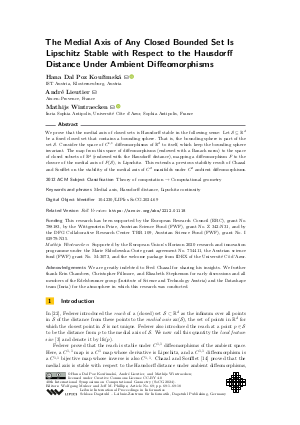LIPIcs.SoCG.2024.69.pdf
- Filesize: 1.53 MB
- 18 pages

 Creative Commons Attribution 4.0 International license
Creative Commons Attribution 4.0 International license

We prove that the medial axis of closed sets is Hausdorff stable in the following sense: Let 𝒮 ⊆ ℝ^d be a fixed closed set that contains a bounding sphere. That is, the bounding sphere is part of the set 𝒮. Consider the space of C^{1,1} diffeomorphisms of ℝ^d to itself, which keep the bounding sphere invariant. The map from this space of diffeomorphisms (endowed with a Banach norm) to the space of closed subsets of ℝ^d (endowed with the Hausdorff distance), mapping a diffeomorphism F to the closure of the medial axis of F(𝒮), is Lipschitz. This extends a previous stability result of Chazal and Soufflet on the stability of the medial axis of C² manifolds under C² ambient diffeomorphisms.































Feedback for Dagstuhl Publishing